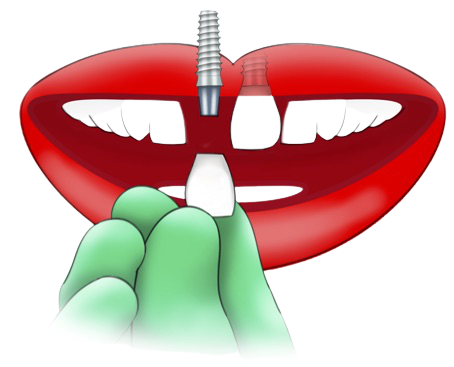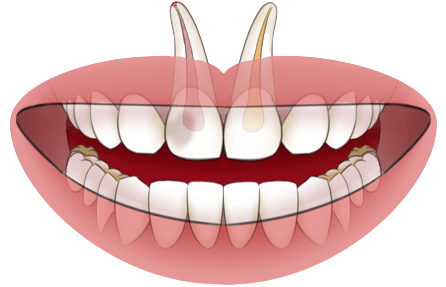Dental check-up
The check-up should take place every six months. It is used to identify tooth, mouth and jaw diseases.
Many dental problems only become noticeable to the patient when they have already moved onto an advanced stage. Treatment is then often more complex than with early intervention.
Professional teeth cleaning
The simple tartar removal is only paid for once a year by the health insurances. A major teeth cleaning, which includes the removal of all hard and soft plaque including discoloration, even in areas that are difficult to access, and individual oral hygiene advice, is only subsidized by a few health insurance companies. According to studies, however, it is an important prerequisite for a good prognosis of tooth and oral health.
Prophylaxis
Individual prophylaxis for children and adolescents up to the age of 18 is paid for by health insurances as soon as the first permanent tooth has come through. It consists of an oral hygiene status by means of staining, oral health education, oral hygiene advice, fluoridation measures and, if necessary, the sealing of the chewing surfaces of the permanent large molars. The sealing of the small, permanent molars must however be paid for privately.
Early detection
The screening test serves to identify tooth, mouth and jaw diseases in children up to six years of age, as well as to prevent tooth decay and gingivitis. During the examination, the oral cavity is examined, oral hygiene advice is given and a recommendation for age-appropriate fluoridation measures is made.
Pediatric dentistry
The development of teeth and dentition should be closely monitored in children from the first tooth onwards. We would be happy to advise you on the subject of oral health, oral hygiene, caries prophylaxis, individual prophylaxis, early detection of dental diseases and misaligned teeth.
Dental fillings
Dental fillings are mainly used to treat small to medium-sized carious defects in the side and front teeth area. Care is taken to ensure that the color of the material used corresponds to that of the tooth in order to ensure that no difference between the filling and the tooth is visible after successful treatment. After the diseased tooth material has been completely removed, the filling material, the so-called composite, consisting of a plastic matrix mixed with ceramic particles, is introduced layer by layer into the tooth in the soft state and cured using cold light. To protect the tooth from blood and saliva during treatment and to ensure a firm bond between tooth and filling, a rubber dam (a type of rubber bandage) is often placed around the tooth. After checking the bite height, the filling is then polished.
Partial crowns & veneers
Partial crowns are used in the posterior region for the restoration of medium-sized and large tooth defects and after root canal treatments to prevent tooth fractures. They can be made from various metals or ceramics. Larger defects in the anterior region can be treated with veneers. These are ceramic veneers that reconstruct the entire visible area of the front teeth or, for aesthetic reasons, can also correct it. The restoration with veneers is more invasive than a restoration, but less invasive than a crown restoration.
Root canal treatments
If a caries is very deep and close to the pulp (on the "nerve"), but also as a result of deep filling therapy, the pulp can become inflamed and die very painfully. The result is a bacterial infection inside the tooth and later inflammation at the root tip, which in turn can lead to painful purulent abscesses. In these cases a root canal treatment is necessary.
The aim of this is extensive disinfection, followed by a root filling and a bacteria-proof closure of the root canal system. It is performed on vital teeth with local anesthesia and, if possible, under a rubber dam. A root canal treatment is always an emergency solution, but it is usually suitable for long-term preservation of an inflamed or dead tooth.
Periodontal therapy
Parodonditis is the inflammation of the teeth holding apparatus due to a bacterial infection. It usually occurs in adults from the middle of the 4th decade of life and is one of the most common infectious diseases. The first thing affected is the gums, which react with swelling and bleeding of the gums. Later on, the inflammation also attacks connective tissue and bones around the tooth, which can lead to loosening and loss of the teeth. As studies suggest, periodontitis increases the risk of developing chronic conditions such as cardiovascular disease and thieves. To counteract this, in addition to a healthy lifestyle and diet, optimal oral hygiene at home should be implemented. If treatment should be necessary, it consists first of all of eliminating all disruptive factors such as carious lesions, defective fillings or teeth that are not worth preserving. Professional teeth cleaning with individual oral hygiene advice is carried out. Once all the pretreatments have been completed, the application for deep pocket and root surface cleaning is submitted to the health insurance company (privately insured patients usually do not have to apply for the treatment). In the case of very deep periodontitis, antibiosis and subsequent surgical therapy may be necessary. This procedure is repeated regularly. The treatment is usually required for a lifetime, as the destruction of the tooth support system is irreversible.
Implants
Implants are artificial tooth roots on which laboratory-made dentures can be attached. The aim is to adapt the artificial teeth to the natural tooth structure as precisely as possible. The treatment takes place in two steps: 1. Before the implants are inserted, the required number of implants, their structure and the best positioning are determined with the help of comprehensive planning and X-ray diagnostics. 2. In the second step, the implants are inserted in several treatment steps, if necessary. Implants are made of titanium or ceramic and are therefore very well tolerated and grow together with the natural tissue after a healing period. They then provide the basis for the implant attachments (e.g. crowns or bridges). The goal is to create an aesthetically beautiful and functionally perfect set of teeth. Although implant-supported dentures are often the most optimal form of dentures today, the placement of implants is not part of the service catalog of statutory health insurance companies.
Removable dentures
Should it be necessary to fill larger tooth gaps, then these can be bridged with the help of a removable prosthesis. A distinction is made between a partial denture (with remaining teeth) and a full denture. Prostheses can consist of various materials and retaining elements. Which ones can be used depends on the individual dental situation.
Fiberglass pins
If the complete natural crown is missing from a tooth, e.g. after an accident, an artificial crown can often be attached using a pin anchored in the root. Such pins can be made of metal or fiberglass. In contrast to metal posts, glass fiber posts are very similar to the hard tooth substance in terms of mechanical properties and reduce the risk of root fractures.
Fixed denture - own teeth
Unlike removable dentures, crowns and bridges are firmly anchored on your own teeth. Strictly speaking, crowns are a coating of the remainder of the tooth with artificial material. The function and appearance of the real tooth is reproduced and the tooth is fully operational again. Even if only a small part of the original tooth is left; As long as the root can still be preserved, the tooth can be artificially rebuilt with the help of various post systems. Bridges are a very good way to successfully close smaller tooth gaps. They can be made of different materials. Which one is used depends on your individual healing plan and is clearly assessed and explained in the consultation. There are two different types of bridge systems: the glue or adhesive bridge (Maryland bridge) and the bridge anchored with crowns. With the adhesive bridge, a tooth is glued to the back of the adjacent teeth using two ceramic or metal plates. It is used in the anterior region when the neighboring teeth are still intact. In the posterior region and in the case of neighboring teeth that have already been damaged, the bridge is attached using crowns.
Surgical crown lengthening
If a tooth has a defect that extends into the root area below the gumline, these areas can be exposed by reducing the gums and bone in order to ensure a functional restoration of the tooth there as well.
Apical resection
If symptoms persist after a root canal treatment and a new root canal treatment cannot be carried out or the prognosis is poor, a tip resection can help in some cases. The cause of persistent pain in root-treated teeth are mostly inflammations in the tissue near the roots, which arise due to bacterially infected areas of the root canal system that have not been sufficiently disinfected with conventional treatment. Usually these areas are in the root tip (finely branched, very narrow or closed root canals). Separating the tip of the root can often lead to lasting healing of the inflammation.
Wisdomtooth removal
Most people have four wisdom teeth, which mostly erupt partially, completely or not at all in adulthood and are located in the back of the jaw. Whether you have wisdom teeth and what position they are in can be determined by means of an X-ray. When wisdom teeth erupt, pain due to swelling, redness or difficulty swallowing can occur. Often there is not enough space and a tooth does not break at all (retained), only partially (partially retained) or crooked, so that the partial covering of the tooth with gums makes it impossible to clean the teeth and inflammation caused by food residues and bacterial deposits can occur . If the wisdom teeth cause these and other problems, such as the displacement of other teeth or caries infestation or pressure on the surrounding tooth roots, the removal of the tooth must be considered. Depending on whether the tooth has already erupted completely, partially or not at all, a decision is made as to which extraction method is used.
Snoring therapy
Some patients experience night snoring. A simple therapy can be done with a snore splint. If there is also a suspicion of a health impairment such as sleep apnea and sleep disorders, a sleep specialist must be consulted. Splint therapy may also help here. Such treatment, although it has been investigated by studies, is currently not included in the canon of statutory dental services and must be paid for privately.
Anxiety patients
Many patients are afraid of dental surgery. In most cases, with empathy, comprehensive advice and by explaining the necessary therapies, treatment can be carried out without any problems. In some cases, medication can also be used beforehand.
Bleaching
Do you want a gentle whitening of your teeth? We would be happy to advise you on possible procedures.






